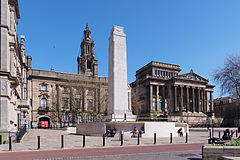WWI and the foundation of NUS
As part of a new history project in conjunction with Northumbria University and UCL, Dr Sarah Hellawell looks at how the First World War led to the creation of the National Union of Students.
The First World War (1914–1918) transformed British society. The impact of war was also felt at British universities. The demobilisation of service personnel at the end of the war coincided with a sharp increase in the student population. Those whose studies had been disrupted by war service resumed their education, while others embarked on university courses for the first time. Between 1918 and 1922, men and women who had served on the front line were a distinguishable cohort at universities and colleges. These students and their memories of the war had a transformative impact on student activism. In an attempt to promote internationalism, young people sought to forge links across Europe through humanitarian relief work and foreign travel. In 1922, British students founded the National Union of Students (NUS) to maintain links with their European peers.
Despite the impact of the war on student life, this aspect of post-war reconstruction has surprisingly been overlooked by historians. A new project led by Dr Daniel Laqua, Dr Georgina Brewis and myself (Dr Sarah Hellawell) will examine the impact of the war on student activism. The project on ‘British Ex-Service Students and the Re-Building of Europe, 1919–1926’ is funded by the Arts and Humanities Research Council’s World War One Engagement Centre at the University of Hertfordshire and will involve collaboration with the NUS and the North East Workers’ Educational Association to recover this episode in the history of student activism.
Over the coming months, I will use these blog posts to share some of our research findings on student activism after the war, the NUS’ formative years, and evidence from our two case-studies: Durham University and University College London. In this post, I will elaborate on the transformation of the student cohort after 1918 and the impact made by ex-service students on university life.
A Scheme for the Higher Education of Ex-Service Students
The 1918 Education Act included provision for university grants for ‘ex-officers and men of British nationality who served during the War in the Navy, Military, or Air Forces of the Crown’. The government pledged to provide assistance to ex-servicemen for tuition fees and living costs during their studies. Between 1918 and 1923, the government spent approximately eight million pounds providing university grants to 27,772 ex-service students across England and Wales. The Scottish Education Department awarded 5,891 grants to ex-service students through a similar scheme. Government assistance facilitated a rise in student numbers. In the 1919–20 academic year, there were 17,000 ex-service students at universities in the UK. Universities had to negotiate the additional pressure on resources and staff caused by this sudden influx of students. Ex-service students also contributed to the diverse range of extra-curricular activities on offer.
Ex-Service Student Activism
Ex-service personnel altered the social composition of the student cohort. Notably, the majority of these students were older than average due to the disruption of the war. Some were married with children and could claim support for their dependents through the scheme. The Board of Education noted that ‘the presence of older men who had been through the difficulties, anxieties and responsibilities of war was having a marked and very wholesome effect on the younger generation of students by adding an intensity and seriousness to undergraduate life’. In particular, ex-service students were instrumental in the revival and establishment of student societies, such as sports teams, debating societies and student representative councils. At Armstrong College (part of Durham University until 1937, and a forerunner of the current Newcastle University) it was noted that societies had regained their ‘pre-war vigour’ due to the influence of ex-service students.
However, by 1922 the majority of ex-service students had completed their courses, sparking fears that societies would become moribund without their leadership. Nonetheless, the formation of the National Union of Students in 1922 is the most significant impact that ex-service students had on university life in Britain. Ivison S. Macadam, the first NUS President, had served in the Royal Engineers during the war. Macadam attributed the formation of NUS as ‘a direct outcome of the war’, claiming that ‘the ex-service element in it has been very strong’. We are hoping to unpack Macadam’s claims further. As part of this project, we aim to illuminate the influence of ex-service students on the early years of NUS.
Dr Sarah Hellawell
August 2017
This project is holding a public event on the 7th October. For more information, click here.



